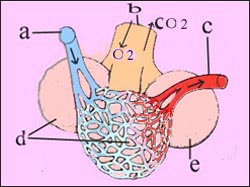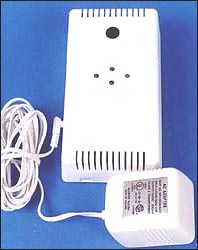Carbon monoxide poisoning 일산화탄소 중독
Overview of carbon monoxide poisoning
Breathing carbon monoxide (CO) air with a high concentration of carbon monoxide for long or short periods of time can lead to carbon monoxide poisoning.
Types of carbon monoxide poisoning
Carbon monoxide poisoning caused by breathing air with high concentrations of carbon monoxide for a short period of time is called acute carbon monoxide poisoning.
Carbon monoxide poisoning caused by breathing air with high concentrations of carbon monoxide for several days is called chronic carbon monoxide poisoning. Carbon monoxide poisoning
- Mild carbon monoxide poisoning,
- Moderate carbon monoxide poisoning,
- Severe can be classified as carbon monoxide poisoning.

▴ Figure 1-10.
Structure of alveoli, pulmonary capillary vein, pulmonary capillary artery, alveoli The a-pulmonary arterioles, b-terminal bronchioles, c-pulmonary venules, d and e-alveoli, CO₂ (carbon dioxide) and O₂ (oxygen) are exchanged in the alveoli. Copyright ⓒ 2011 John Sangwon Lee, MD., FAAP
Hemoglobin is normally contained in red blood cells.
]When breathing, oxygen that enters the alveoli attaches to hemoglobin. Hemoglobin carries oxygen to the cells of all tissues in all organs of the body.
When carbon monoxide and oxygen are in the alveoli or blood at the same time, the affinity that carbon monoxide attaches to hemoglobin is 200 times stronger than the affinity that oxygen attaches to hemoglobin.
For some reason, when you breathe more than normal in high-concentration carbon monoxide air, hemoglobin carries more carbon monoxide to all the tissue cells of the body instead of transporting oxygen to the tissue cells of all organs throughout the body. This can lead to poisoning with carbon monoxide.
Depending on the severity of carbon monoxide poisoning, oxygen deficiency occurs in all tissue cells throughout the body, and in severe cases, tissue cells fall into a state of asphyxiation. In other words, when breathing air with a high concentration of carbon monoxide, oxygen is attached to hemoglobin in red blood cells and becomes oxygen hemoglobin. Instead, carbon monoxide is attached to hemoglobin and becomes carbon monoxide hemoglobin (Carboxyhemoglobin/CoHgb).
As a result, hemoglobin cannot carry enough oxygen to each tissue cell in the body as needed.
In this case, the amount of hemoglobin in the blood is normal, but oxygen deficiency occurs in the body and eventually, carbon monoxide poisoning occurs. In other words, although the concentration of hemoglobin in the blood is normal, symptoms of severe anemia may occur.
Causes of carbon monoxide poisoning Incorrectly installed heating devices,
Ventilation system installed insecurely,
When burning petroleum, coal, or charcoal in an enclosed place with poor ventilation,
When the car engine has not been turned off for a long time in a closed car, When you are in an enclosed garage parked for a long time without turning off the car engine for a long time,
When breathing high concentrations of carbon monoxide from a fire,
Other than that, breathing air with high levels of carbon monoxide can lead to carbon monoxide poisoning.
You can be poisoned by carbon monoxide or other types of toxic gases without getting burned in a place where there is a fire.
Carbon monoxide poisoning can occur when briquettes are fired in poorly ventilated areas.
Symptoms signs of carbon monoxide poisoning
Symptoms of carbon monoxide poisoning differ depending on the concentration of carbon monoxide in the air you are breathing, how long you have breathed high concentrations of carbon monoxide or the concentration of carbon monoxide hemoglobin in the blood attached to hemoglobin.
It is normal for hemoglobin to contain a small amount of carbon monoxide. Hemoglobin with carbon monoxide is called CoHgb.
The normal blood level of CoHgb is 5% or less. When the blood level of CoHgb is above 20%, symptoms of carbon monoxide poisoning begin to appear remarkable, when it is about 30%, severe carbon monoxide poisoning can occur, and when the concentration is above 60%, death is common (see suffocation).
When mild carbon monoxide poisoning occurs acutely, the head may be heavy and painful, there may be strange noises in the ear, difficulty concentrating, and symptoms such as dizziness and muscle pain may occur.
When you are severely addicted to carbon monoxide, you are confused, vomiting, peeing, convulsions, and almost loss of consciousness. When chronically mildly addicted to carbon monoxide, the head is sore, dizzy, nauseous, nauseous, dull, dizzy, memory loss, sleep disorders, neuritis, recurrent infectious diseases, abdominal pain, polycythemia, neuropsychiatric disorders, etc.
Symptoms may occur. Long-term breathing of air with a carbon monoxide concentration above normal can lead to chronic carbon monoxide poisoning. At this point, your hearing may be reduced and the efficiency of your usual daily tasks may not increase.
When very severely poisoned by carbon monoxide, the size of the eyes becomes larger than normal (mydriasis occurs), the face becomes pale, breathes quickly or slowly, loses consciousness, convulses, and eventually dies.
Manual of emergency pediatrics 4th edition, Robert M. Reece, M.D. See p.224 Summarizing the symptoms and signs of carbon monoxide poisoning that can occur when the concentration of carbon monoxide increases and the time to breathe carbon monoxide becomes longer and longer.
At first, it starts with asymptomatic no-signs → then it leads to fatigue, headache, anxiety and depression → neuropsychiatric dysfunction, general fatigue, goosebumps, abdominal pain, confusion, dizziness, etc.→ ataxia, convulsions → myocardial infarction, Cerebral infarction, loss of consciousness → ends with death.
Source; The New England Journal of Medicine, March 19, 2009, p.1218.
Diagnosis of carbon monoxide poisoning
If carbon monoxide poisoning is suspected by combining medical history, symptoms, and medical examination findings, the concentration of carbon monoxide attached to hemoglobin, that is, carbon monoxide hemoglobin (carbon monoxide hemoglobin/Carboxyhemoglobin/CoHgb), is measured and diagnosed.
Carbon monoxide poisoning is diagnosed by referring to the fact that it was in an enclosed place where briquettes, charcoal, gas, etc., burned, in a car that was left without turning off the engine, or in the garage where such a car was parked for a long time.
Time, see Prevention of carbon monoxide poisoning accidents).
able 44. Symptoms signs according to the concentration of carbon monoxide hemoglobin (carbon monoxide hemoglobin)
표 44. 일산화탄소 헤모글로빈(일산화탄소 혈색소) 농도에 따른 증상 징후
| 일산화탄소 헤모글로빈 농도가 1% 이하When driving on a highway with a carbon monoxide hemoglobin concentration of 5% or less | 정상 it is considered normal |
| 일산화탄소 헤모글로빈 농도가 5% 이하 a carbon monoxide hemoglobin concentration of 5% or less, | 고속도로에서 차를 몰 때는 차내에서는 정상으로 본다.When driving on a highway with |
| 일산화탄소 헤모글로빈 농도가 10% 이하
th a carbon monoxide hemoglobin concentration of 10% or less are considered normal |
담배를 피우는 사람의 경우 정상으로 본다. People who smoke cigarettes wi
|
| 일산화탄소 헤모글로빈 농도가 15% 일 때
When the carbon monoxide hemoglobin concentration is less than 15%, |
육체적 운동을 하는 동안 숨이 조금 가쁘고 앞 머리가 조금 띵하고 얼굴홍조가 생기는 등 증상 징후가 경미하게 나타날 수 있다. symptoms may appear mildly during physical exercise, such as shortness of breath, a little thin front head, and facial flushing |
| 일산화탄소 헤모글로빈 농도가 20% 일 때
When the carbon monoxide hemoglobin concentration is 20%, |
육체적 운동을 하지 않는 동안 숨이 가쁘고 앞 머리와 측두에 율동적 두통이 생기는 것이 보통이다. shortness of breath and rhythmic headaches in the forehead and temporal region are common during non-physical exercise |
| 일산화탄소 헤모글로빈 농도가 30% 일 때
When the concentration of carbon monoxide hemoglobin is 30%, |
신경이 예민해지고 두통, 피로, 판단력 이상, 시야장애, 어지럼 등의 증상이 생긴다. nerves become sensitive and symptoms such as headache, fatigue, abnormal judgment, visual disturbance, and dizziness occur. |
| 일산화탄소 헤모글로빈 농도가 40~50% 일 때
When the carbon monoxide hemoglobin concentration is 40-50%, |
두통, 혼동, 육체적 운동 실조, 기절 등의 증상이 생긴다. symptoms such as headache, confusion, physical ataxia, and fainting occur |
| 일산화탄소 헤모글로빈 농도가 60~70% 일 때
When the carbon monoxide hemoglobin concentration is between 60 and 70%, |
의식 천명도가 상당히 감소된다. 경련, 호흡부전증 등이 생긴다. wheezing is significantly reduced. Convulsions, respiratory failure, etc. occur. |
| 일산화탄소 헤모글로빈 농도가 80% 이하
Carbon monoxide hemoglobin concentration is 80%.
|
짧은 시간 내 사망한다. Death occurs in a short time. |
Treatment of carbon monoxide poisoning
If you suspect carbon monoxide poisoning, give priority to moving the child from the site to a safe place. Depending on the degree of carbon monoxide poisoning, call a medical paramedic, hospital emergency room, or regular pediatrics department by emergency phone call and take them to the hospital emergency room by ambulance or other appropriate means according to their instructions. When you are mildly addicted, the whole treatment is to breathe fresh air. However, when severely poisoned, 100% oxygen breathing treatment or high pressure 100% oxygen breathing treatment is performed to quickly separate carbon monoxide from hemoglobin.
This oxygen therapy is treated until the concentration of carbon monoxide (Carboxyhemoglobin/CoHgb) attached to hemoglobin falls below 5%. When you fall into a coma due to severe carbon monoxide poisoning, you may already have brain damage due to oxygen deficiency, and the brain may be swollen. In this case, the brain edema that has already occurred should be properly treated. Other people who breathe air with high levels of carbon monoxide in the same place can also become addicted to carbon monoxide.
Because of this, those who were with him should also receive appropriate treatment. It also prevents carbon monoxide from poisoning again. If the concentration of carbon monoxide is higher than normal, you can prevent carbon monoxide poisoning by installing a carbon monoxide alarm that sounds an alarm.

▴ Photo 1-37. A carbon monoxide alarm can be used to prevent carbon monoxide poisoning. Copyright ⓒ 2011 John Sangwon Lee, MD., FAAP
출처 및 참조 문헌
-
Childhood Emergencies in the Office, Hospital and Community, American Academy of Pediatrics
-
Emergency Medical Service for Children, By Ross Lab. May 1989. p.10
-
Emergency care, Harvey grant, and Robert Murray
-
Emergency Care Transportation of Sick and Injured American Academy of Orthopaedic Surgeons
-
Emergency Pediatrics A Guide to Ambulatory Care, Roger M. Barkin, Peter Rosen
-
Immediate care of the acutely ill and injured, Hugh E. Stephenson, Jr
-
The Critically Ill Child, Diagnosis and Management, Edited by Clement A. Smith
-
Emergency Medical Services for Children: The Role of the Primary Care Provider, America Academy of Pediatrics
-
Quick Reference To Pediatric Emergencies, Delmer J. Pascoe, M.D., Moses Grossman, M.D. with 26 contributors
-
Manual of Emergency Care 응급환자관리 정담미디어
-
소아가정간호백과–부모도 반의사가 되어야 한다, 이상원
-
Neonatal Resuscitation American heart Association
-
Neonatology Jeffrey J.Pomerance, C. Joan Richardson
-
Pediatric Resuscitation Pediatric Clinics of North America, Stephen M. Schexnayder, M.D.
-
Pediatric Critical Care, Pediatric Clinics of North America, James P. Orlowski, M.D.
-
Preparation for Birth. Beverly Savage and Dianna Smith
-
Nelson Textbook of Pediatrics 14th ed. Beherman,
-
The Johns Hopkins Hospital, The Harriet Lane Handbook, 18th edition
-
Red book 29th-31st edition 2021
-
Nelson Text Book of Pediatrics 19th-21st Edition
-
Infectious disease of children, Saul Krugman, Samuel L Katz, Ann A. Gershon, Catherine Wilfert
-
The Harriet Lane Handbook 19th Edition
-
소아과학 대한교과서
-
제1권 소아청소년 응급의료 참조문헌과 출처
-
Other
Copyright ⓒ 2015 John Sangwon Lee, MD., FAAP
“부모도 반의사가 되어야 한다”-내용은 여러분들의 의사로부터 얻은 정보와 진료를 대신할 수 없습니다.
“The information contained in this publication should not be used as a substitute for the medical care and advice of your doctor. There may be variations in treatment that your doctor may recommend based on individual facts and circumstances. “Parental education is the best medicine.”